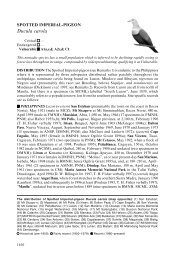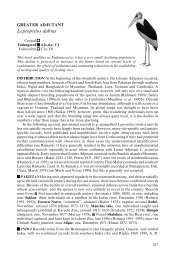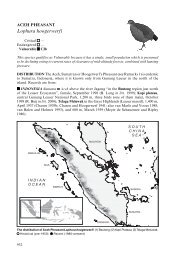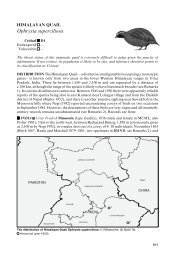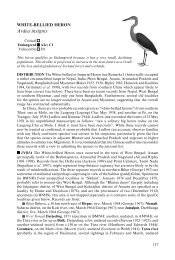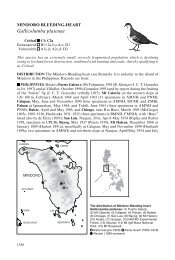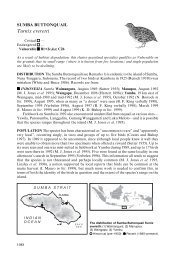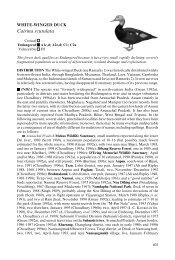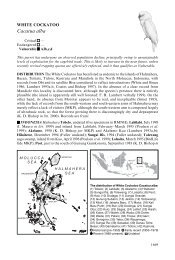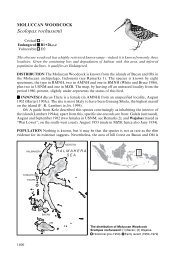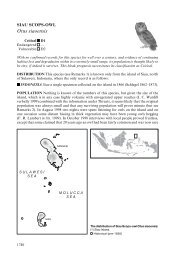Mycteria cinerea - BirdBase
Mycteria cinerea - BirdBase
Mycteria cinerea - BirdBase
You also want an ePaper? Increase the reach of your titles
YUMPU automatically turns print PDFs into web optimized ePapers that Google loves.
Threatened birds of Asia<br />
(763) and South Sumatra (1,587); in July–August 1985 of 1,029 in Jambi (697) and South<br />
Sumatra (732); and again in March–April 1986 of 1,937 in Jambi (1,134), and South Sumatra<br />
(803); on the basis of these data these three provinces were judged to hold the majority of the<br />
world population (Danielsen and Skov 1985, Silvius 1988). In September 1988 at Tanjung<br />
Koyan 300–400 nests were estimated to be present, with a total of 500 birds including at least<br />
50 juveniles; at Tanjung Selokan 300 nests were estimated to be present, with a total of 150<br />
birds including several juveniles; and on the Banyuasin peninsula 280 nests were observed<br />
along with 250 adults and 100 juveniles (Danielsen et al. 1991a), with as many as 1,000 birds<br />
there subsequently (Verheugt et al. 1993). These welcome findings were in part offset by the<br />
subsequent discovery of the loss of the colony within Hutan Bakau Pantai Timor reserve,<br />
Jambi province (Danielsen et al. 1991b), which must be taken as reasonably likely to represent<br />
a real decline in overall numbers.<br />
Early in the twentieth century the species was clearly seasonally very common in Java,<br />
with large colonies (“many nests”, or 75–100 nests) noted in the Citarum delta (Bartels 1915–<br />
1930, Hoogerwerf 1936a). By the mid-1980s, the breeding population was tiny but the island<br />
experienced influxes of other birds (Lambert and Erftemeijer 1989); the total population of<br />
West Java was estimated at c.400 (356–408 individuals) (Allport and Wilson 1986; also<br />
Verheugt 1987). Over 1,000 individuals have been reported to visit the north-east coast of<br />
Java seasonally (Hancock et al. 1992), but this is possibly an overestimation. Surveys of the<br />
south coast of Central Java yielded a minimum of 164 birds, but without confirmation of<br />
breeding (Erftemeijer et al. 1988), and surveys in East Java found only 38 birds (Erftemeijer<br />
and Djuharsa 1988). Pulau Rambut may be the last breeding site on the north coast of Java,<br />
since the species is known to have ceased breeding on Pulau Dua in 1975 and at an unspecified<br />
date in the Brantas or Solo deltas of East Java, indicating a considerable decline; the maximum<br />
number of nests recently found was 10 in 1984 (14 given in Allport and Wilson [1986]). A<br />
recent record of 170 individuals on Madura (Oriental Bird Club Bull. 24 [1996]: 59–65)<br />
suggested that the island may support an important numbers of the species, at least seasonally.<br />
The population on Sulawesi appears to have increased in recent years, although this is<br />
almost certainly a result of greater observer coverage and surveying of new areas, especially<br />
in South-east Sulawesi (Bishop in press). As many as 73 birds were discovered at a variety of<br />
coastal sites in South Sulawesi in 1986, suggesting a modest resident population in the province<br />
(Uttley 1987). South-east Sulawesi may hold a small but valuable population, with c.100 in<br />
Rawa Aopa Watumohai National Park in 1995 (Wardill et al. 1995). Breeding has not been<br />
proven on the island (Bishop in press), although sightings of juveniles suggests that it is very<br />
likely to occur. In 1996 the species was also noted at three localities on Buton, with 21 birds<br />
in one tree, and an immature also seen, suggesting local breeding (Catterall undated).<br />
ECOLOGY Habitat Throughout much of its range, the Milky Stork is essentially a coastal<br />
species, favouring mangroves, mudflats and estuaries (Hancock et al. 1992). It also feeds on<br />
ricefields and fishponds (Verheugt 1987). This is certainly the case in its Sumatran heartland,<br />
although it occasionally visits “lebaks” (backswamps along river floodplains) up to 150 km<br />
from the coast; during spring tides, birds often roost in remnant trees in ricefields (Verheugt<br />
et al. 1993; also Danielsen and Skov 1985, 1987). Roost sites are sometimes in the crowns of<br />
tall mangrove trees (Hancock et al. 1992), although they also regularly roost on the ground<br />
out on mudflats or in marshes (Bartels 1915–1930), a factor that makes the species relatively<br />
easy to count, even from the air (e.g. Parish and Wells 1985). In Peninsular Malaysia, the<br />
species is “more exclusively marine” than its congener the Painted Stork (Robinson and<br />
Chasen 1936), the suggestion being that the two separate ecologically when they meet<br />
(Morioka and Yang 1990). However, they were reported to frequent the same marshy plains<br />
in Cambodia, often in the same flock (Delacour and Jabouille 1931), and recent reports from<br />
Cambodia again suggest that they use or used similar habitats (Mundkur et al. 1995a, C. M.<br />
174



